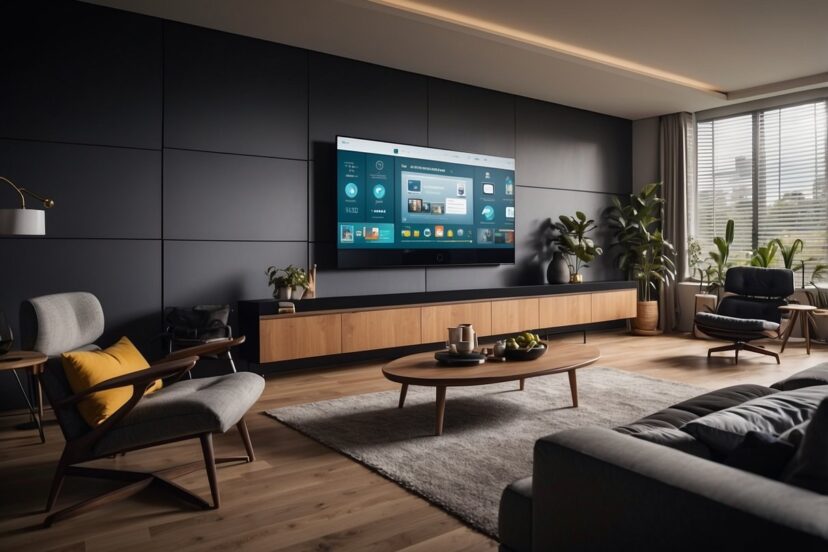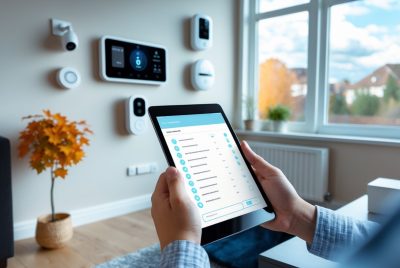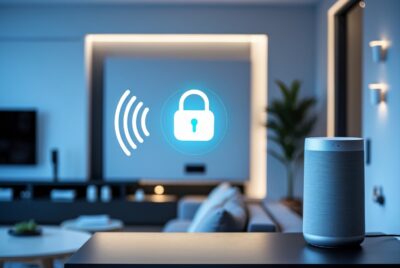How to Make a Smart Home: A Guide to Automation
*We may earn a commission for purchases made using our links. Please see our disclosure to learn more.
How to Make a Smart Home: A Comprehensive Guide to Automation
Making a smart home can transform the way you live by adding convenience, efficiency, and security to your daily routine. By integrating devices such as smart lights, thermostats, and security cameras, I can control my home with ease using voice commands or smartphone apps. A smart home system allows me to customize my environment to suit my needs and preferences.

To start building my smart home, I need to plan what devices are essential and how they’ll connect to my existing Wi-Fi network. Most devices use the 2.4-GHz frequency, which provides a reliable connection throughout the house. With the right setup, I can automate everyday tasks, improving my comfort and peace of mind.
Finding the right smart home ecosystem is important, as it ensures compatibility between devices. Hubs like Amazon Alexa, Google Assistant, or Apple HomeKit can help manage multiple gadgets seamlessly. Choosing the right ecosystem can greatly enhance the functionality and connectivity of all my smart devices.
Understanding Smart Home Basics

Setting up a smart home involves using technology to automate and control household functions, making everyday tasks easier and more efficient. In the sections below, I’ll cover what a smart home is, its benefits, and the technology that powers it.
What Is a Smart Home?
A smart home uses internet-connected devices to manage and control various household functions such as lighting, heating, and security. These devices can be controlled remotely through a smartphone or tablet, and many can also be automated based on schedules or conditions.
Common smart home devices include smart lights, thermostats, locks, cameras, and speakers. They communicate using Wi-Fi, Bluetooth, or other wireless protocols. This setup allows for seamless integration and control via apps or voice commands.
Benefits of a Smart Home
A smart home offers many advantages including convenience, security, and energy efficiency. With smart devices, I can control my home from anywhere, get alerts about unusual activities, and even create automation routines to save energy.
For instance, I can program my thermostat to adjust the temperature when I’m not home, which reduces energy use and lowers utility bills. Smart security systems also provide peace of mind with real-time notifications and remote access to video feeds.
Technology Behind Smart Homes
The backbone of a smart home is a robust Wi-Fi network. Most smart devices operate on either the 2.4 GHz or 5 GHz frequency bands, with many using the 2.4 GHz band for better range. Reliable internet and strong security protocols are essential for smooth and safe operations.
Devices often communicate via hubs that connect them to the home network. Popular protocols include Zigbee, Z-Wave, and Bluetooth. Each has its pros and cons, but all are designed to ensure that devices can work together efficiently. A secure setup with encryption helps to protect against unauthorized access.
Planning Your Smart Home Setup

Planning a smart home involves selecting a central hub, identifying your needs, budgeting, and ensuring device compatibility. This setup can significantly enhance convenience and home efficiency.
Choosing a Central Hub
The central hub acts as the brain of your smart home. Some popular options include Amazon Alexa, Google Assistant, and Apple HomeKit.
I recommend researching the specific features of each platform. Amazon Alexa offers a wide array of compatible devices. Google Assistant integrates well with Google services and devices. Apple HomeKit is ideal if you already use many Apple products.
Consider how well each hub will fit into your current setup and future plans. Ensure the hub supports the devices you plan to use.
Identifying Your Smart Home Needs
Outline what you want your smart home to accomplish. Common needs include security, lighting, climate control, and entertainment.
Make a list of must-haves and nice-to-haves. For security, consider smart locks and cameras. For lighting, look at smart bulbs and switches. Climate control can involve smart thermostats. Entertainment options might include smart speakers and TVs.
Identifying your needs helps avoid overspending on unnecessary gadgets. It also ensures you focus on getting the right devices for your home.
Budget Considerations
Creating a smart home can be an investment. It’s important to establish a budget before purchasing devices.
List the costs of essential items such as the central hub, sensors, cameras, smart lights, and other devices. Check for bundles or discounts on smart home devices, which can save money.
Remember that while more expensive devices often offer better features, there are also budget-friendly options that work well.
Compatibility and Interoperability
Not all smart devices work with every hub. Ensuring compatibility is crucial for a smooth smart home experience.
Identify if the devices you want are compatible with your chosen hub. For example, some devices only work with specific platforms like HomeKit or SmartThings.
Interoperability ensures that different devices can communicate and work together. This enhances the efficiency and performance of your smart home system without frustrating compatibility issues.
Installing Smart Home Devices

Transforming your home into a smart home involves setting up various devices that enhance convenience, security, and efficiency. Below, I explain how to install smart lighting, security systems, HVAC controls, and appliances.
Smart Lighting Solutions
Smart lighting can be easily installed by replacing existing bulbs with smart bulbs or using smart plugs. To start:
- Choose a smart lighting ecosystem (e.g., Philips Hue, Wyze, LIFX).
- Replace each bulb with a smart bulb or plug in a smart plug.
- Download the corresponding app.
- Connect the bulbs or plugs to your Wi-Fi network.
- Configure the settings through the app.
With these steps, you can control your lights with your phone or voice commands using assistants like Alexa or Google Assistant.
Smart Security Systems
Smart security systems offer peace of mind by monitoring your home. These systems often include cameras, door/window sensors, and alarms. Here’s how to set them up:
- Install the base station where it has a strong Wi-Fi signal.
- Place cameras and sensors around access points such as front and back doors, windows, and the garage.
- Mount the keypad near the main entrance.
- Download the app and follow the setup instructions.
- Configure the system to alert your phone when triggered.
Most systems come with step-by-step guides, making the installation process straightforward.
Heating, Ventilation, and Air Conditioning (HVAC)
Smart HVAC systems help regulate your home’s temperature efficiently. To install a smart thermostat:
- Turn off your HVAC system at the breaker.
- Remove the existing thermostat.
- Connect the smart thermostat according to the wiring diagram.
- Mount the thermostat and turn the power back on.
- Download the thermostat’s app and connect it to Wi-Fi.
Follow the prompts to configure schedules or adjust settings for energy savings. Many smart thermostats also learn your preferences over time.
Smart Appliances and Outlets
To modernize your appliances and outlets, consider smart plugs and smart kitchen gadgets. Here’s how:
- Plug in a smart outlet to any standard socket.
- Connect it to your Wi-Fi via the device’s app.
- Attach appliances such as coffee makers or lamps.
- Configure and control the appliance through the app.
For smart appliances like refrigerators or ovens, follow the manufacturer’s instructions. These devices often offer advanced features such as remote monitoring and alerts.
By following these steps, you can effectively install and integrate smart home devices, enhancing functionality and convenience in your daily life.
Configuring Your Smart Home

Configuring your smart home involves setting up user interfaces, programming automation and scenes, integrating with virtual assistants, and enabling remote access and control to get the best experience.
Setting Up User Interfaces
User interfaces are crucial for controlling smart devices effortlessly.
I recommend starting with a smart hub that connects all your devices. Many smart home systems, like those from Amazon or Google, offer a central hub.
Install device-specific apps, as they provide detailed controls. For example, use the Philips Hue app for smart lights or the Nest app for thermostats.
On a smartphone, add widgets for quick access. Wall-mounted control panels are also handy and provide physical control points throughout your home.
Programming Automation and Scenes
Automation lets devices work together based on specific triggers.
I find it helpful to group actions into “scenes.” For instance, create a “Good Morning” scene that turns on lights, starts the coffee maker, and adjusts the thermostat.
Use IFTTT (If This Then That) to set up custom actions. For example, you can program your lights to turn on when you arrive home.
Schedules can be set for convenience, like dimming lights in the evening. Sensors trigger automations too; for instance, a motion sensor can turn on the hallway light at night.
Integration with Virtual Assistants
Virtual assistants make it easier to control devices using voice commands.
Use Amazon Alexa, Google Assistant, or Apple Siri for this purpose. Enable the relevant skills or actions in the virtual assistant’s app to link your devices.
Voice control allows you to perform tasks hands-free, like adjusting the lights while cooking. For more advanced integration, create routines that combine several actions with one command.
For example, saying “Goodnight” could lock doors and turn off lights.
Remote Access and Control
Remote access provides control over your smart home even when you’re not there.
Ensure all devices are connected to the internet. Use the manufacturer’s app to access devices remotely. This is handy for checking security cameras or adjusting the thermostat while away.
Enable two-factor authentication for added security. This way, your data and devices remain protected from unauthorized access.
Monitoring and controlling devices from anywhere adds convenience and peace of mind.
Maintaining and Updating Your Smart Home

Keeping your smart home in top shape involves regular checkups, resolving connectivity problems, updating software, and smart upgrades. Here’s what you need to know.
Regular System Checkups
I find it’s essential to do routine checks on all my smart home devices. Inspect sensors, batteries, and connections at least once a month. Look for points of failure such as loose wires or dead batteries. Clean devices to prevent dust buildup which can interfere with sensors. A regular check helps catch minor issues before they become big problems.
Dealing with Connectivity Issues
Connectivity issues can disrupt the harmony of a smart home. Start by ensuring your Wi-Fi router is positioned centrally within your home. This provides even coverage. Reset your router periodically to maintain optimal performance. If a device keeps dropping out, check for interference from other electronics or physical barriers. Consider a Wi-Fi extender if certain areas of your home have poor signal strength.
Software and Firmware Updates
I can’t stress this enough: regularly update the firmware and software of your smart home devices. Updates often include security patches and enhancements. Most apps notify you when updates are available. Set aside a specific time each month to check for and install updates. This ensures your devices continue to work smoothly and safely.
Expanding Your Smart Home
When adding new devices, start with those that have the most significant impact. Smart thermostats, lights, and security cameras are great for initial expansion. Ensure new devices are compatible with your existing system to avoid any hiccups. Carefully read installation instructions and follow them closely. Test new devices thoroughly to make sure they integrate well without causing issues.
Frequently Asked Questions
Creating a smart home involves understanding the essential components, choosing a suitable ecosystem like Google, Alexa, or Apple, knowing the costs involved, upgrading existing homes, considering design for beginners, and exploring innovative setup ideas.
1. What are the essential components required to create a smart home?
A smart home includes devices like smart speakers, thermostats, lighting, and security systems. Each device is connected to a central hub, usually controlled via an app on your smartphone. Reliable Wi-Fi is crucial for seamless operation.
2. How do I start setting up a smart home with a specific ecosystem like Google, Alexa, or Apple?
Choose your preferred ecosystem (Google Home, Amazon Alexa, or Apple HomeKit). Purchase compatible devices. Set up the central device, such as a Google Nest Hub, Amazon Echo, or Apple HomePod. Follow the setup instructions in the ecosystem’s app to connect and control all devices.
3. What is the average cost to convert a traditional house into a smart home?
The cost varies based on the level of automation and the devices you choose. Basic setups with smart lights and a few speakers might cost a few hundred dollars. More advanced systems, including smart thermostats, security cameras, and automated doors, might run into several thousand dollars.
4. Can I upgrade my existing home into a smart home, and how can I do it?
Yes, you can upgrade your existing home into a smart home. Begin by installing smart bulbs, plugs, and speakers. Gradually add more complex devices like smart locks, cameras, and thermostats. Use compatible devices with a central control system for ease of integration.
5. What are innovative smart home setup ideas that enhance everyday living?
Consider smart lighting that adjusts to your schedule, smart thermostats for energy efficiency, and voice-activated devices for hands-free control. Integrate smart cameras and doorbells for enhanced security. Use smart kitchen appliances that can be controlled remotely to streamline your daily routines.




